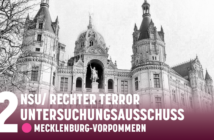 The national socialist underground (NSU) – racist murders, bomb attacks, neo-nazi networks and state collusion.
The national socialist underground (NSU) – racist murders, bomb attacks, neo-nazi networks and state collusion.
Rosa-Luxemburg-Foundation published the the Dissenting Opinion of Parliamentary Group DIE LINKE
The exposure of the “National Socialist Underground” (NSU) neo-Nazi network around the core trio of three neo-Nazis – the deceased Uwe Böhnhardt and Uwe Mundlos and Beate Zschäpe – has been a long and strenuous effort. Since November 4, 2011, the German public and police have learned that two alleged bank-robbers – Uwe Mundlos (38) and Uwe Bönhardt (38), who were found dead in a caravan in the city of Eisenach (Thuringia) after a bank robbery – and their accomplice Beate Zschäpe (37), who turned herself in to the police on November 8, 2011, after having set an apartment and half of a house on fire in the city of Zwickau (Saxony) on the same day that her long-term companions died in Eisenach, had formed the presumed core trio of a murderous neo-Nazi network called “National Socialist Underground” (NSU).
Shortly after November 4, 2011, a DVD was sent to several news media and organisations in which the NSU claimed responsibility for the murder of nine migrants of Turkish, Kurdish and Greek descent in the years 2000 to 2006; the killing of a police-officer and the near fatal shooting of her colleague in the city of Heilbronn in 2007, and two bomb attacks in the city of Cologne in 2001 and 2004. The bomb that exploded in the Keupstrasse in Cologne on June 10, 2004, was a nailbomb that injured two dozen passers-by and visitors to a hairdresser in front of which the bomb had been placed in a bicycle case. Investigators later also learned that the presumed NSU core trio had been living in the cities of Chemnitz and Zwickau (Saxony) with the help of at least three dozen male and female neo-Nazi supporters – i. e. using assumed identities, passports and driver’s licenses and health insurance cards of neo-Nazi supporters to rent apartments and caravans – for nearly thirteen years. They had escaped arrest in January of 1998 when police let them slip away after the discovery of three pipe-bombs and 1.2 kg of TNT in a garage rented in the city of Jena (Thuringia), where the three neo-Nazis had been active since the early 1990s in a militant neo-Nazi organisation called “Kameradschaft Jena” (companionship Jena), which was part of a larger organisation named “Thüringer Heimatschutz” (Thuringian Homeland Security). Police also learned in November 2011 that the three had financed their activities with the help of more than a dozen bank robberies in the Eastern federal states of Saxony, Mecklenburg-Western Pomerania and Thuringia.
Even though the police realized early on in the investigation of the racist murders that they were faced with murder series in which the perpetrators were using the same weapon – a Ceská 83 pistol of Czech origin – over and over again, hundreds of policemen who were involved in the investigation around the murder series were unable to come up with the idea that the murder series was motivated by racism and had been perpetrated by neo-Nazis. Instead, until November 2011, the racist murder series – which had been dubbed “the Döner killer series” by the police and the German media even though only two of the victims had been working in Turkish fast-food shops whereas the other seven victims had been working as small business owners selling flowers, vegetables, keys, newspapers, or sweets or were sewing clothes – had been publicly blamed by the police and the media on a “Turkish mafia” and “organized crime by migrants”.
Continue reading in the pdf.


